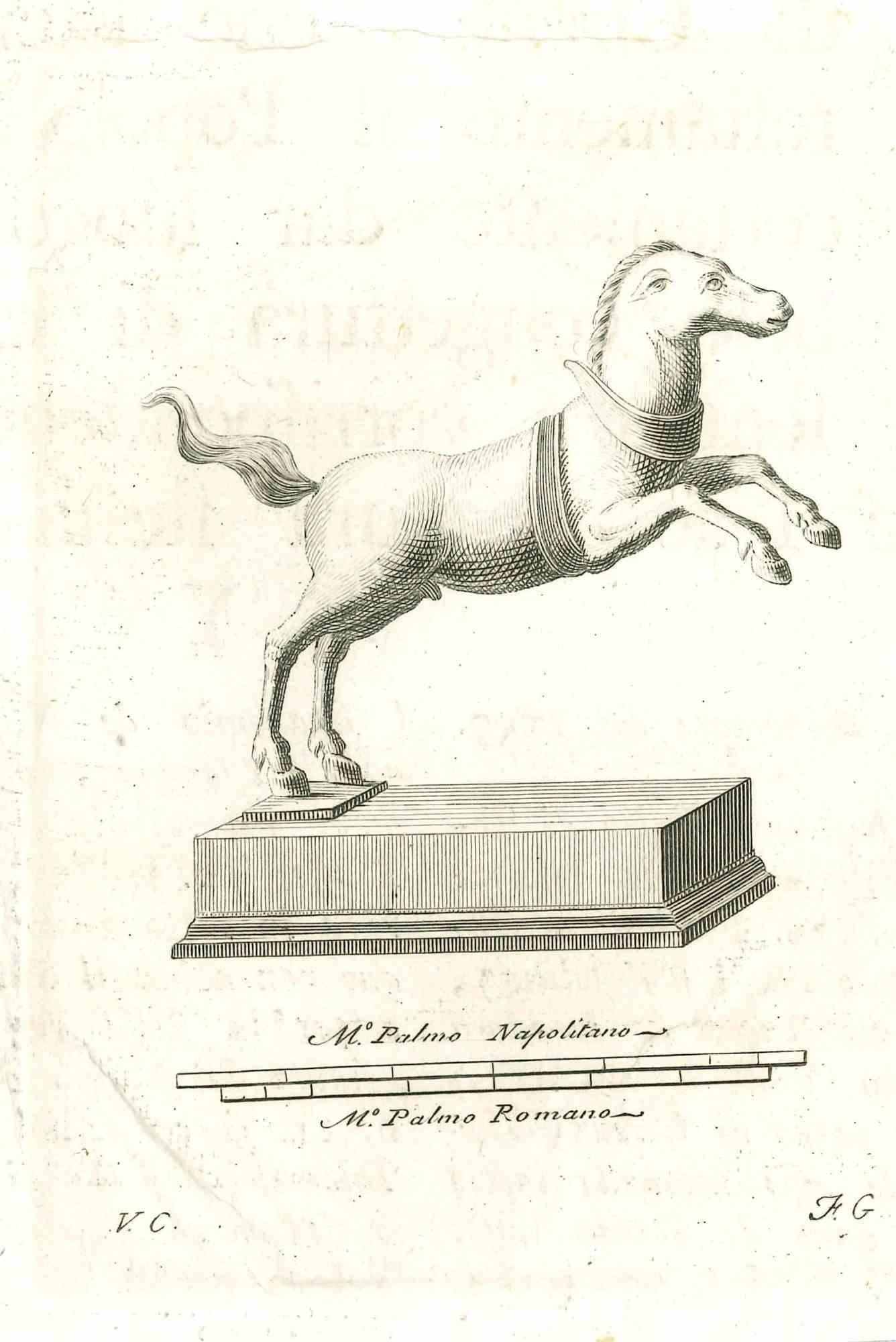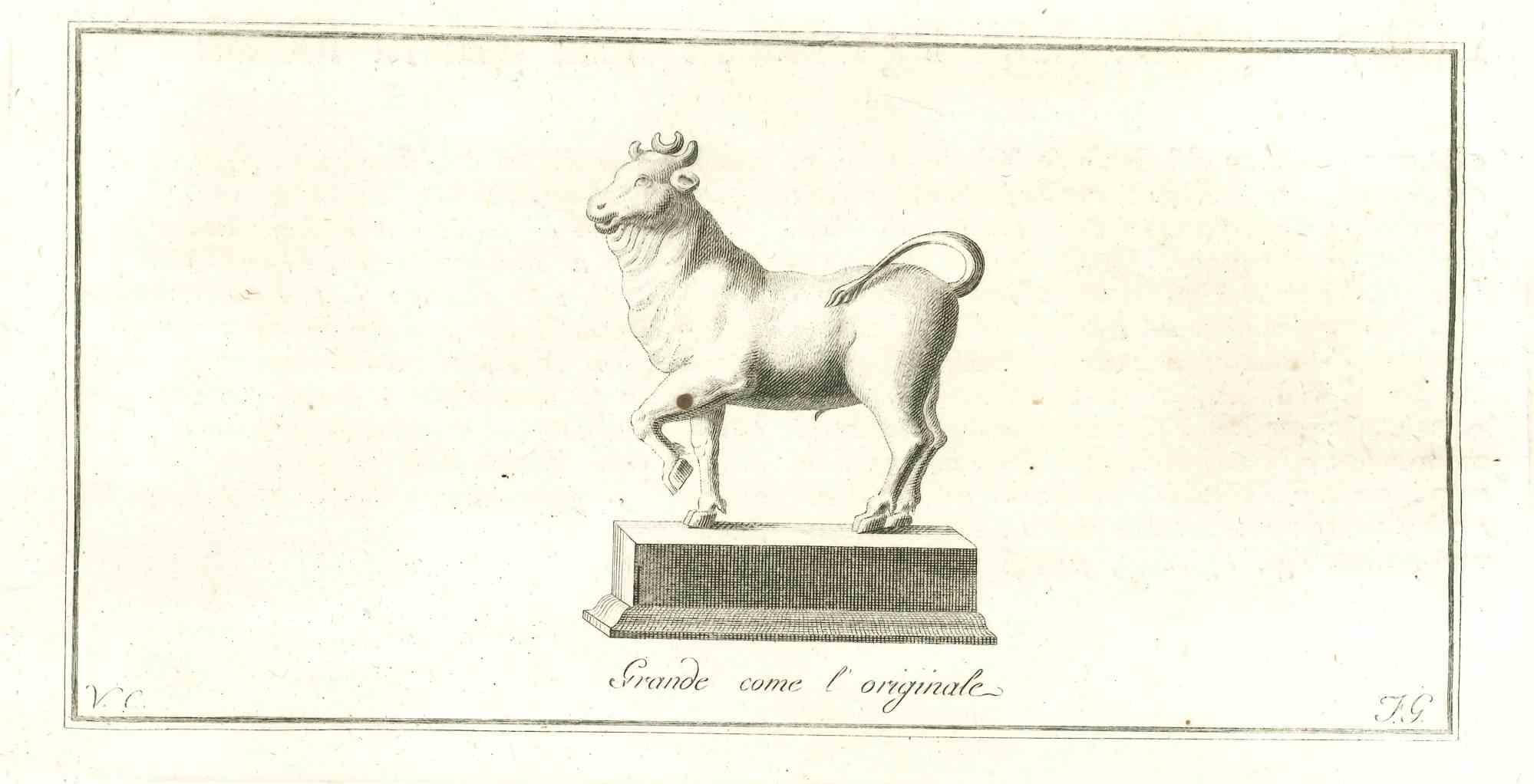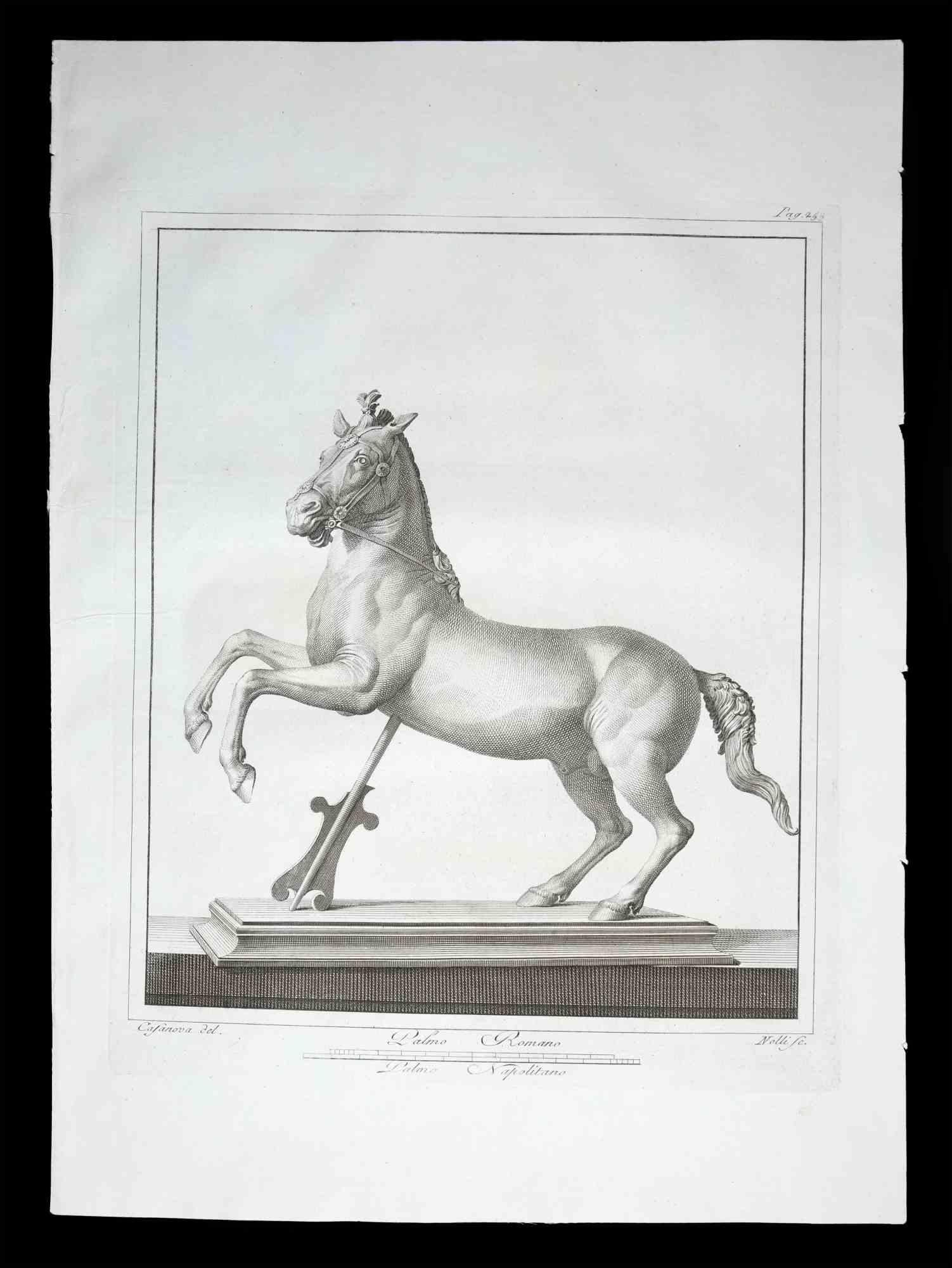Objekte ähnlich wie Antike Exemplare des Herculaneum Exposed- Original-Radierung - 18. Jahrhundert
Möchten Sie mehr Bilder oder Videos?
Zusätzliche Bilder oder Videos von dem*der Anbieter*in anfordern
1 von 2
UnknownAntike Exemplare des Herculaneum Exposed- Original-Radierung - 18. JahrhundertLate 18th Century
Late 18th Century
Angaben zum Objekt
Antiquities of Herculaneum Exposed, original etching from the end of the 18th century, made by Various Old Masters.
Guter Zustand.
The etching belongs to the print-series Antiquities of Herculaneum Exposed (original title: Le Antichità di Ercolano Esposte), eight volumes of engravings of the finds from the excavation of the ruins of Herculaneum in the Kingdom of Naples (today Campania, Italy).
It was published between 1757 and 1792 by the Regia Stamperia and later these copies were delivered to selected recipients throughout Europe.
Despite the title, the Antiquity of Herculaneum shows objects from all the excavations undertaken by the Bourbons in the Gulf of Naples. These include Pompeii, Stabia and two sites of Herculaneum: Resina and Portici.
The Bourbon king Charles commissioned fifteen scholars to create a new “Herculaneum Academy” to study the finds and publish the results of the archaeological excavations of the sites.
The engravings are of high quality and the accompanying text shows a large scholarship.
They were made by 25 leading artists involved by the King to prepare drawings and engravings on the finds, among which we find Giovanni Elia Morghen, Carlo Nolli, Luigi Vanvitelli and Giovanni Battista Casanova.
The "Antiquity" was designed more to amaze readers with the quality of the objects in the collection of the King of Naples than to be used in research, following and increasing the interest of eighteenth-century society for classical culture and art in particular.
Through the exaltation of the classical concept of proportion and harmony, the book inspired the neoclassical movement in Europe, giving artists and decorators access to a vast workshop of Hellenistic motifs.
Ref .:
National Gallery (Washington), Mark J. Millard Architectural, IV (2000), n. 1.
L. Garcia y Garcia, Nova bibliotheca Pompeiana (2 v., 1998).
Royal Institute of British Architects, British Architectural Library ... First Printed Books, 1 (1994), no. 112.
U. Pannuti, Engravers and designers of the Royal Printing House of Naples in the 18th century: the publication of the Antiquities of Herculaneum, in Xenia antiqua, 9 (2000), p. 151-178.
V. Trombetta, The edition of The Antiquities of Herculaneum exhibited in Rendiconti of the Academy of Archeology, Letters and Fine Arts of Naples, 59 (1984), p.151-172.
- Entstehungsjahr:Late 18th Century
- Maße:Höhe: 12 cm (4,73 in)Breite: 24 cm (9,45 in)Tiefe: 2 mm (0,08 in)
- Medium:
- Bewegung und Stil:
- Zeitalter:
- Rahmen:Rahmenoptionen verfügbar
- Zustand:Insurance may be requested by customers as additional service, contact us for more information.
- Galeriestandort:Roma, IT
- Referenznummer:
Informationen zu dem*der Anbieter*in
4,9
Platin-Anbieter*in
Diese von Expert*innen geprüften Anbieter*innen sind die erfahrensten Anbieter*innen von 1stDibs und werden von unseren Kund*innen am besten bewertet.
1stDibs-Anbieter*in seit 2017
6.767 Verkäufe auf 1stDibs
Typische Antwortzeit: 3 Stunde
- VersandAngebot wird abgerufen …Versand von: Monaco, Monaco
- RückgabebedingungenDie Rückgabe dieses Objekts kann innerhalb von 14 Tagen ab Lieferung veranlasst werden.
Einige Inhalte dieser Seite wurden automatisch übersetzt. Daher kann 1stDibs nicht die Richtigkeit der Übersetzungen garantieren. Englisch ist die Standardsprache dieser Website.
Mehr von diesem*dieser Anbieter*inAlle anzeigen
- Antike römische Statue - Original-Radierung von Vincenzo Campana - 18. JahrhundertVon Vincenzo CampanaAntike römische Statue, aus der Serie "Altertümer von Herculaneum", ist eine Originalradierung auf Papier, die von Vincenzo Campana im 18. Signiert auf der Platte unten links. Gute...Kategorie
Spätes 18. Jahrhundert, Alte Meister, Figurative Drucke
MaterialienRadierung
- Antike Antiquitäten des Herculaneum- Original-Radierung von C. Oratij- 18. JahrhundertAntiquitäten von Herculaneum aufgedeckt, Original-Radierung vom Ende des 18. Jahrhunderts, von verschiedenen alten Meistern geschaffen. Signiert unten links auf der Platte Carlo Or...Kategorie
Spätes 18. Jahrhundert, Alte Meister, Figurative Drucke
MaterialienRadierung
- Antike Exemplare des Herculaneum Exposed- Original-Radierung - 18. JahrhundertAntiquitäten von Herculaneum aufgedeckt, Original-Radierung vom Ende des 18. Jahrhunderts, von verschiedenen alten Meistern geschaffen. Guter Zustand.. Die Radierung gehört zu de...Kategorie
Spätes 18. Jahrhundert, Alte Meister, Figurative Drucke
MaterialienRadierung
- Antike römische Statue - Original-Radierung von Vincenzo Campana - 18. JahrhundertVon Vincenzo CampanaAntike römische Statue, aus der Serie "Antiquitäten von Herculaneum", ist eine Originalradierung auf Papier, die von Vincenzo Campana im 18. Signiert auf der Platte unten links. Gute...Kategorie
Spätes 18. Jahrhundert, Alte Meister, Figurative Drucke
MaterialienRadierung
- Antikes römisches Fresco-Herculaneum – Radierung von Vanni – 18. JahrhundertAntikes römisches Fresko aus der Serie "Antiquitäten von Herculaneum", ist eine Original-Radierung auf Papier, die von Vanni im 18. Signiert auf der Platte. Guter Zustand bis auf e...Kategorie
Spätes 18. Jahrhundert, Alte Meister, Figurative Drucke
MaterialienRadierung
- Antike römische Pferdestatue - Original-Radierung von Carlo Nolli - 1700er JahreVon Carlo NolliAntike römische Statue eines Pferdes, aus der Serie "Antiquitäten von Herculaneum", ist eine Originalradierung auf Papier von Carlo Nolli aus dem 18. Jahrhundert. Signiert auf der P...Kategorie
18. Jahrhundert, Alte Meister, Figurative Drucke
MaterialienRadierung
Das könnte Ihnen auch gefallen
- MarkttagVon Marius BauerMarkttag. 1889. Radierung und Kaltnadelradierung. Wisselingh 42. 7 5/8 x 5 13/16 (Blatt 8 3/8 x 6 3/8). Auflage 100. Gedruckt auf cremefarbenem Büttenpapier. Mattenbrand und Tonung i...Kategorie
Spätes 19. Jahrhundert, Alte Meister, Figurative Drucke
MaterialienRadierung
- Fairy Tale, ein MärchenVon Marius BauerEin Märchen. 1897. Radierung. Wisselingh 18. 2 3/4 x 4 3/8 (Blatt 5 9/16 x 7 5/8). Ausgabe 100, Nr. 51. Ein reicher Abdruck auf cremefarbenem Büttenpapier. Mit Bleistift signiert und...Kategorie
Spätes 19. Jahrhundert, Alte Meister, Figurative Drucke
MaterialienRadierung
- „Nohubo remedio“ (Es gab keine Lösung) – Radierung und Aquatinta auf PapierVon Francisco Goya„Nohubo remedio“ (Es gab keine Lösung) – Radierung und Aquatinta auf Papier Kühne 3. oder 4. Auflage, ca. 1868-1878, mit brünierten Aquatinten, Kaltnadelradierungen und Kupferstiche...Kategorie
1790er, Alte Meister, Figurative Drucke
MaterialienGravur, Papier, Radierung, Aquatinta
- Nach Giuseppe Cesari (Italiener 1568-1640), der den Drachen erschlgtVon Giuseppe CesariKünstler: Nach Giuseppe Cesari (Italiener 1568-1640) Titel: Der Heilige Georg erschlägt den Drachen Medium: Giclée Fine Art Print auf Ilford Galerie Textured Cotton Rag 310gsm Papier. Blattgröße: Höhe 42 cm x Breite 42 cm Über das Gemälde: Der Heilige Georg, der den Drachen erschlägt, ist ein Genrebild, das von der Legende des Heiligen Georg abgeleitet ist, einem im Christentum verehrten Soldaten, der gegen einen Drachen kämpft und ihn besiegt. Die Geschichte erzählt von einem Drachen, der ein Dorf um seinen weltlichen Besitz erpresste. Nachdem die Dorfbewohner all ihr Vieh, ihr Geld und ihre Schmuckstücke aufgebraucht...Kategorie
16. Jahrhundert, Alte Meister, Figurative Drucke
MaterialienArchivtinte, Hadernpapier
- Nach Giuseppe Cesari (1568-1640), nachdem der Heilige Georg den Drachen geschoben hatteVon Giuseppe CesariÜber das Gemälde: Der Heilige Georg, der den Drachen erschlägt, ist ein Genrebild, das von der Legende des Heiligen Georg abgeleitet ist, einem im Christentum verehrten Soldaten, der gegen einen Drachen kämpft und ihn besiegt. Die Geschichte erzählt von einem Drachen, der ein Dorf um seinen weltlichen Besitz erpresste. Nachdem die Dorfbewohner all ihr Vieh, ihr Geld und ihre Schmuckstücke...Kategorie
16. Jahrhundert, Alte Meister, Figurative Drucke
MaterialienMetall
- Vogele – 21. Jahrhundert, figürlicher Druck, Schwarz-Weiß, TiereVon Anna MikkeLimitierte Auflage, 8/10. ANNA MIKKE (geb. 1950) Sie schloss 1975 ihr Studium an der Akademie der Bildenden Künste in Łódź ab. Nach dem Studium war sie als Grafikdesignerin tätig und...Kategorie
2010er, Sonstige Kunststile, Figurative Drucke
MaterialienPapier, Radierung





